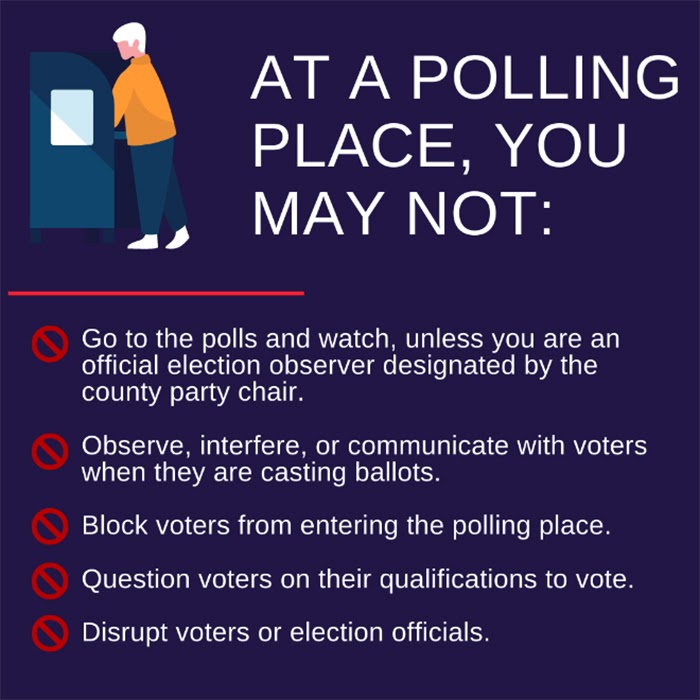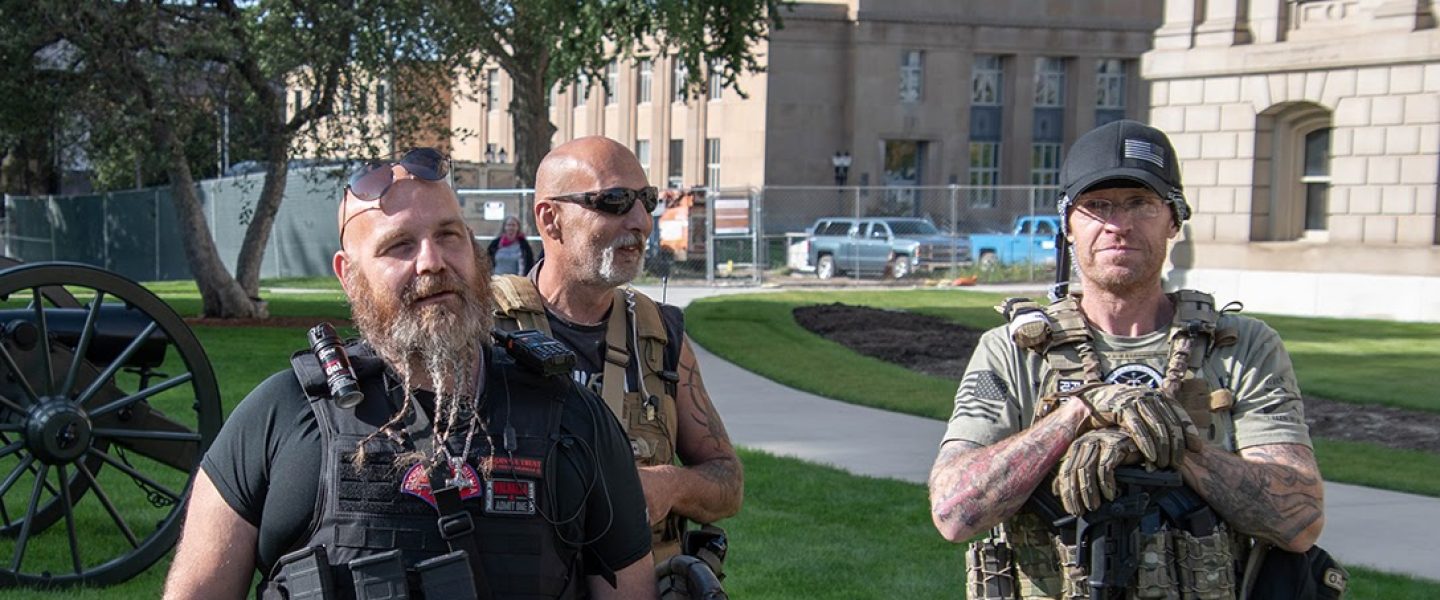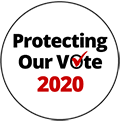Voter intimidation concerns grow as voting gets underway in open-carry states.
|
Listen To This Story
|
With the proliferation of heavily-armed right-wing militias this year, voting-rights activists and election officials across the country are increasingly worried about widespread voter intimidation, especially in states where people are allowed to openly carry firearms.
Such fears were underscored when the FBI and state authorities arrested 13 armed men for allegedly plotting to kidnap Michigan Governor Gretchen Whitmer, Virginia Governor Ralph Northam, and other state officials earlier this month. The men, some of whom were members of a self-proclaimed militia group, were charged with terrorism, conspiracy, and weapons possession, among other charges.
Michigan’s Secretary of State Jocelyn Benson responded by issuing a ban on the open carry of firearms within 100 feet of polling stations and in hallways used by voters. But a Michigan Court of Claims judge struck down the order on Tuesday, following two lawsuits — one of which was brought by three gun rights groups. The judge ruled Benson had exceeded her authority.
Michigan Attorney General, Dana Nessel appealed the decision on Wednesday. “We will have this resolved by November 3rd,” Nessel told WSJM radio.
But the problem could also quickly escalate in other so-called battleground states like Virginia, Wisconsin, North Carolina, and Pennsylvania: they all are open carry states, meaning that individuals are allowed to carry firearms in public.
None of these four states has explicit laws prohibiting someone from showing up at a polling place with a gun, putting the responsibility of responding to voter intimidation threats on state and local law enforcement. Still, in recent weeks, authorities in several open carry states have come forward to denounce the potential for voter intimidation, an act that is prohibited by federal and state law.
The move was applauded by Josh Horwitz, executive director of the Coalition to Stop Gun Violence. “I’m very glad to see that attorneys general and secretaries of state are taking it very seriously,” he said in an interview with WhoWhatWhy.
One statistic that alarms officials across the country is the spike in gun sales since the COVID-19 pandemic began. In June alone, the FBI’s National Instant Criminal Background Check System (NICS) conducted 3.9 million firearms background checks nationwide, a 70 percent increase compared to the same month last year.
These numbers are particularity worrisome for various organizations that track violent white supremacist groups. They found evidence that a number of right-wing extremist groups are actively mobilizing online to carry out acts of violence around election day. The surge followed President Trump repeatedly urging his supporters to build an “army” of poll watchers to flock to polling stations on November 3.
“We are closely watching militia groups and are paying close attention to their potential mobilization around Election Day to engage in voter harassment and/or voter suppression in local communities,” said Devin Burghart, executive director of the Institute for Research & Education on Human Rights. “We are even more concerned, given the traffic that we’re seeing in terms of their chats or conversations, about what might happen on the streets if a result turns up that they don’t like.”
There is precedent for such threats. In the 2016 and 2018 elections, armed civilians demonstrated at polling stations, “and are poised to do it again,” according to the Coalition to Stop Gun Violence in a recent report.
One of the problems posed by widespread gun carrying is that it can complicate police work, discouraging officers from investigating suspicious behavior involving firearms, a 2014 study found on the impact of right-to-carry laws.
“Carrying guns is a huge burden for law enforcement, and it creates a potential for violence in every interaction,” Horwitz told WhoWhatWhy. For him, the line between the right to vote and the right to bear arms should be clear. “That’s when your right ends. You can carry [a firearm], but the second it becomes a weapon of intimidation, then you cross the line.”
Likewise, local law enforcement will face the dilemma of trying to determine in which instance carrying a gun to a poll constitutes voter intimidation.
There should be no question about it, Horwitz argues. “If you’re bringing your guns and you’re standing with a long gun outside of a polling place, there’s only one message you’re sending, and that is intimidation,” he said.
At the moment, only six states have clear laws on the books that prohibit firearms at polling places: Arizona, Georgia, Louisiana, and Texas, which are open carry states, as well as California and Florida.
In Pennsylvania, lawfully carried firearms are permitted inside and adjacent to polling places, according to state police, unless the polling place is located inside a school or court facility, where guns are generally not allowed.
“Open carry is only a question of whether you can openly display an armament, it’s not a question of whether you can join with 50 other people and parade around like you’re a paramilitary group.”
“Whether an activity near a polling place constitutes constitutionally protected free speech or crosses the line into voter intimidation is fact-specific, and decisions will be made by law enforcement, in consultation with the county district attorney, on a case-by-case basis,” Ryan Tarkowski, a spokesperson for the Pennsylvania State Police, told WhoWhatWhy.
“Any activity that is intended to, or has the effect of, interfering with a voter’s right to vote — whether occurring outside or inside of the polling place — is illegal,” Tarkowski said.
But some states find it difficult to define what exactly voter intimidation is. In North Carolina, for instance, which does not have a specific law against firearms at voting sites, “there is not a legal definition of intimidation,” said Laura Brewer, spokesperson for the North Carolina attorney general. “But if a voter feels intimidated, he or she should raise the concern to polling officials or local law enforcement.”
Unless the polling place is inside a school property, a courthouse, or in private buildings that don’t normally allow the display of firearms, lawfully carried firearms are permitted at North Carolina polls.
In an attempt to clarify the issues surrounding voter intimidation, Attorney General Josh Stein issued a voter fact sheet detailing polling stations’ do’s and don’ts.
“If a supporter has not previously been designated as an official election observer, they must stand outside of the 50-foot electioneering area/buffer zone around the polling place,” the fact sheet reads. While supporters are allowed to hand out literature and hold signs, it is illegal to prevent voters from entering polling stations and interfere with or intimidate any voter.
If someone does attempt to do any of these things, the responsibility of preventing “riots, violence, tumult, or disorder” falls on the polling place’s so-called chief judge or site manager, according to North Carolina law.

Chief judges may protect “challengers and witnesses against molestation and violence in the performance of their duties,” a Board of Elections memo states, and they may “[eject] from the place of registration or voting any challengers or witness for violation of any provisions of the election laws.” If the situation escalates, they are instructed to call law enforcement.
While local authorities can prohibit the possession of knives in public buildings, Wisconsin does not have a blanket state law prohibiting guns at polling places. Attorney General Josh Kaul did note in a written announcement that “brandishing or displaying firearms in an intimidating or threatening manner in or near a polling place” could constitute an example of voter intimidation.
Even before the FBI foiled the plot to kidnap Gov. Northam, Virginia state officials were already concerned about the threats posed by private paramilitary groups.
Virginia law makes it illegal “to point, hold or brandish any firearm … or any object similar in appearance, whether capable of being fired or not, in such manner as to reasonably induce fear in the mind of another or hold a firearm … in a public place in such a manner as to reasonably induce fear in the mind of another of being shot or injured.”
Virginia Attorney General Mark Herring noted in a written opinion in September that under Virginia law, members of an unlawful militia “coming as a unit, heavily armed with assault-style weapons, dressed in fatigues and other military accessories, and acting in a coordinated fashion” could face a Class 1 misdemeanor charge for falsely assuming or exercising the functions of a law enforcement officer — punishable by up to one year in prison and a $2,500 fine, what someone can receive for a first DUI offense.
Yet, in the past months at least three counties have approved resolutions to officially authorize the organization and training of local militias, while other rural counties have considered doing the same, the New York Times reported.
A Virginia state police spokesperson told WhoWhatWhy that in the Old Dominion state, state authorities defer to local police who are responsible for analyzing each situation of potential voter intimidation by armed individuals.
The problem with relying entirely on local law enforcement or polling officials, however, is that, in some places, local sheriffs might have a friendly attitude toward so-called militias and might ignore voter intimidation attempts. For that reason, Michigan Attorney General Dana Nessel said in mid-October that state troopers will be sent to counties where sheriffs might not enforce the firearm ban if it is upheld by election day, the Detroit Metro Times reported.
While none of the five open carry states has officially banned firearms at polling places, all of them have the constitutional power to do so, according to the Coalition to Stop Gun Violence’s report.
“They absolutely should,” said Igor Volsky, executive director of Guns Down America.
“The current threat that armed militia and other extremists pose to our democracy is built upon years of systemic racism and voter suppression, both exacerbated by the inequities highlighted by COVID-19,” the Coalition’s report states.
Politically inspired violence has historical precedent in the country. Throughout the Reconstruction era following the Civil War, the Ku Klux Klan and their predecessors used all sorts of tactics to terrorize African Americans trying to vote. It was common to see “a white supremacist cavalry or militia sweep through individual towns in an actual armed-to-the-teeth military conflict,” said R. Volney Riser, professor of history at the University of West Alabama.
But looking at history, the threat of violence might have had as much an impact, if not more, as the violence itself, according to Riser. “What you have to have is people being afraid that violence is going to come,” he said.
Riser argues that while the current threats of violence have a “very uncomfortable rhyme to past events,” it does not have to be widespread to be as alarming.
“If a single American citizen of voting age, in a single polling place, feels threatened by a single polling observer, that is an inexcusable stain upon the entire election,” he said.
Right-wing extremist groups may feel legitimized by the president’s shout-outs but militias have no constitutional standing, especially when they claim they are acting in quasi-security roles during protests, said Thomas Patterson, Bradlee Professor of Government & the Press at Harvard University’s Kennedy School of Government.
The Supreme Court ruled in the 2008 DC v. Heller decision that the Second Amendment guarantees an individual the right to possess a firearm for lawful purposes, such as self-defense within the home. But the decision makes clear that so-called private militias are not legitimate and have no constitutional authority.
Yet, some militia members interpret the wording of the Second Amendment to fit their beliefs while exploiting ambiguous open carry laws.
“Open carry is only a question of whether you can openly display an armament, it’s not a question of whether you can join with 50 other people and parade around like you’re a paramilitary group,” Patterson said.
For Riser, the historical antecedents of today’s militias are clear. “If it’s 1874 and I see the Klan parading around the polling place, that is bad and it is frightening, and they are not there to help. Similarly, [today] if I have a bunch of guys patrolling polling places in Michigan with unnecessarily long guns strapped across their backs, they’re there to scare somebody,” he said.
—
For more of WhoWhatWhy’s work on Protecting Our Vote, see our Student Voter Guide and our series America Decides 2020. You can also find out the darker secrets behind our voting systems in our recently published e-book Is This Any Way to Vote?: Vulnerable Voting Machines and the Mysterious Industry Behind Them by Celeste Katz Marston and Gabriella Novello, available on Amazon now.
Related front page panorama photo credit: Adapted by WhoWhatWhy from Fibonacci Blue / Flickr (CC BY 2.0).





